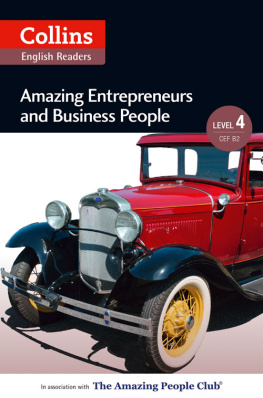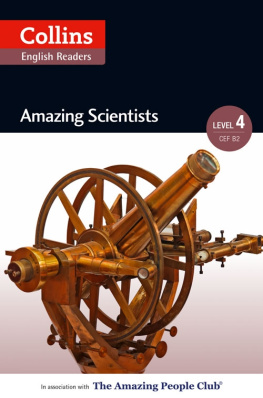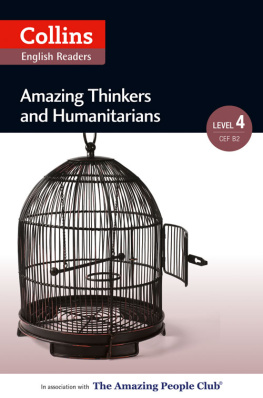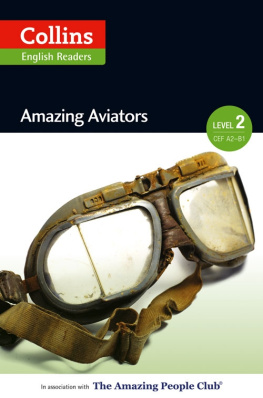Collins Amazing People Readers are collections of short stories. Each book presents the life story of five or six people whose lives and achievements have made a difference to our world today. The stories are carefully graded to ensure that you, the reader, will both enjoy and benefit from your reading experience.
You can choose to enjoy the book from start to finish or to dip into your favourite story straight away. Each story is entirely independent.
After every story a short timeline brings together the most important events in each persons life into one short report. The timeline is a useful tool for revision purposes.
Words which are above the required reading level are underlined the first time they appear in each story. All underlined words are defined in the glossary at the back of the book. Levels 1 and 2 take their definitions from the Collins COBUILD Essential English Dictionary and levels 3 and 4 from the Collins COBUILD Advanced English Dictionary.
To support both teachers and learners, additional materials are available online at www.collinselt.com/readers.
The Amazing People Club
Collins Amazing People Readers are adaptations of original texts published by The Amazing People Club. The Amazing People Club is an educational publishing house. It was founded in 2006 by educational psychologist and management leader Dr Charles Margerison and publishes books, eBooks, audio books, iBooks and video content, which bring readers face to face with many of the worlds most inspiring and influential characters from the fields of art, science, music, politics, medicine and business.
The Collins COBUILD Grading Scheme has been created using the most up-to-date language usage information available today. Each level is guided by a brand new comprehensive grammar and vocabulary framework, ensuring that the series will perfectly match readers abilities.
CEF band | Pages | Word count | Headwords |
Level 1 | elementary | A2 | | 5,0008,000 | approx. 700 |
Level 2 | pre-intermediate | A2B1 | | 8,00011,000 | approx. 900 |
Level 3 | intermediate | B1 | | 11,00015,000 | approx. 1,100 |
Level 4 | upper intermediate | B2 | | 15,00019,000 | approx. 1,700 |
For more information on the Collins COBUILD Grading Scheme, including a full list of the grammar structures found at each level, go to www.collinselt.com/readers/gradingscheme.
Also available online: Make sure that you are reading at the right level by checking your level on our website (www.collinselt.com/readers/levelcheck).

18441919
the man who invented tomato ketchup

I always loved growing and selling vegetables. I worked at other professions but I always returned to my garden. I never imagined that a simple tomato sauce would have such an impact on the world.

I was born on 11th October 1844, in Pittsburgh, Pennsylvania, in the USA, and I was the first of eight children. My parents named me Henry John Heinz, a name I later used for my company, H. J. Heinz. Four years before my birth, my parents had emigrated to the USA from Bavaria in Germany. In the beginning, life was difficult for them as they did not speak English. However, they had come to America to work hard and create a better life for themselves and their family, and that is what they did.
In 1850, we moved to a town eight kilometres from Pittsburgh called Sharpsburg. My father, John Henry, had a brickyard a place where bricks used in construction work were made and sold. On one side of the brickyard there was some spare land that my father did not use and on it, my mother Anna Margaretha grew all of our fruit and vegetables.
I learned a great deal from my mother and father. They worked hard, saved their money and sent me to school to make sure I had a good education. When I was 14, my parents wanted me to become a priest and they even enrolled me in a special school. They were both religious people and they were members of a type of Protestant church. However, this was not the career I wanted to follow.
I think I had a natural talent for business because when I was 8 years old, I started selling my mothers vegetables to our neighbours. By the time I was 12, I was growing vegetables on a piece of land that measured more than 14 square metres. I had a long list of customers, some who were even as far away as Pittsburgh. Two years later, I did a couple of classes in accounting at a school called Duffs Mercantile College, which was the first business school in America.
My mother had started making different kinds of pickles. These were vegetables that had been kept in either vinegar or salt water for a few months. They developed a strong flavour from the vinegar or salt and became really tasty. I also sold these to the customers we already had, and by selling in the streets, our customer list grew.
In 1859, when I was 15, I stopped taking classes at school and went to work with my father at the brickyard. I continued growing and selling vegetables and pickles, but I also started a little business all of my own. One of the vegetables we grew was a small plant called horseradish, whose roots had a strong spicy taste. It was possible to make a white sauce from the roots, which was very good when eaten with roast beef. I started selling my horseradish sauce along with the other vegetables.
I was not the first person to sell horseradish sauce but mine was presented in a different way. Until now, all the other sellers of the sauce put it into dark glass bottles, so that you couldnt see what was inside. Some of the manufacturers had a bad reputation because pieces of other cheaper vegetables, and even small pieces of wood, had been found in their sauces. I put my sauces into transparent glass jars so the customer could see exactly what they were buying. Almost overnight, my horseradish sauce and pickles became amazingly popular.
In 1865, with the money I had made from selling horseradish sauce, and the wages I was earning, I bought half of my fathers business. The population of towns like Sharpsburg and Pittsburgh was growing, and people needed new houses to live in. It was a good time to be making and selling bricks. Three years later, one of my friends called Clarence Noble also became a partner in the brickyard. It was a profitable business but I felt that for me, something was missing and I knew that I didnt want to stay at the brickyard permanently. I missed growing vegetables and making pickles and horseradish sauce, so Clarence and I went into a different business.
In 1869, we started the Anchor Pickle & Vinegar Works. In addition to our horseradish sauce, we also produced pickled cucumbers and celery sauce. The following year we changed the name of our company to Heinz, Noble & Company. It may sound rather impressive but in reality it was quite simple. I decided that I did not want to wait for customers to come to me. Instead, I went into the streets and sold our products from a cart that was pulled by a horse. By taking our products to the people, we got direct feedback without the need of a market researcher with a questionnaire. Every day, we talked with the local people. None of our customers was rich and they spent their money carefully, so it was important for me to provide quality products that were also healthy.












